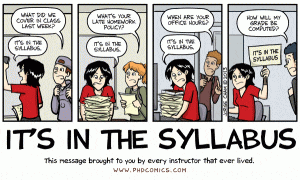Why so serious? Three reasons to use humor in your classroom

“A good laugh is a mighty good thing, a rather too scarce a good thing.” — Herman Melville observed. Beyond bar-rooms in Moby Dick, this applies to much of higher education today, as well. Even though laughter and smiling have been shown to be associated with a string of physiological and psychological benefits, humor remains one of the most underutilized tools in education.
Two reasons come to mind for the generally stone-faced nature of instruction most of us have been subject to and subject others to.
The first argument goes like this: science/engineering/college is serious business. How can we expect others to respect our authority if we are joking around?
I argue that we should all use humor in our classrooms precisely because teaching students is serious business. If we are committed to enhancing our students’ learning experience as much as possible, we have to seriously consider using humor in our classes for that purpose.
How does humor foster learning?
#1. Humor builds trust.
Laughter in humans evolved to signal safety. Hominids millions of years ago laughed during fleeting periods of safety to promote social interaction (1), strengthening group cohesion. This instinctive laughter later on developed into conscious, controllable laughter, which we use today to signal friendliness.
“When students laugh, they are more relaxed and more able to engage in learning. Also, if I say ridiculous things, it gives them permission to say things that may or may not be right – it lowers the stakes for participation” – shares Dr. Ruth Poproski, Assistant Director of Faculty Teaching and Learning Initiatives for the Center for Teaching and Learning.
 Establishing trust is essential to achieve optimal results in any social setting, where multiple people collaborate to achieve a common goal (2). In education, our shared goal is learning – to which end we would like our students to participate in class, to ask questions and to experiment with new and unfamiliar ideas. Students look to instructors for signals regarding what is appropriate in the class. When instructors model how mistakes and unusual ideas can be treated with a sense of humor and a good dose of self-reflection, the psychological distance between instructor and student decreases (3), which can go a long way in alleviating students’ anxiety and fostering their engagement.
Establishing trust is essential to achieve optimal results in any social setting, where multiple people collaborate to achieve a common goal (2). In education, our shared goal is learning – to which end we would like our students to participate in class, to ask questions and to experiment with new and unfamiliar ideas. Students look to instructors for signals regarding what is appropriate in the class. When instructors model how mistakes and unusual ideas can be treated with a sense of humor and a good dose of self-reflection, the psychological distance between instructor and student decreases (3), which can go a long way in alleviating students’ anxiety and fostering their engagement.
#2. Humor fosters retention.
 The delivery of a concept in a relevant, humorous form can ensure that the idea gets to our long-term memory. I still vividly remember the moment from Statistics, when the professor illustrated the limitations of using means with a simple sentence: “If we were to describe the average human to an alien, it would have approximately one breast, one testicle and slightly less than two legs.” The example was so striking, so unexpected and so graphic, that the class was rolling with laughter. But more importantly, to this day, when I read an article touting high confidence in their conclusions based on hazy statistics, the one-breasted, one-testicled average human wobbles into my mind cautioning me about accepting the results without more scrutiny.
The delivery of a concept in a relevant, humorous form can ensure that the idea gets to our long-term memory. I still vividly remember the moment from Statistics, when the professor illustrated the limitations of using means with a simple sentence: “If we were to describe the average human to an alien, it would have approximately one breast, one testicle and slightly less than two legs.” The example was so striking, so unexpected and so graphic, that the class was rolling with laughter. But more importantly, to this day, when I read an article touting high confidence in their conclusions based on hazy statistics, the one-breasted, one-testicled average human wobbles into my mind cautioning me about accepting the results without more scrutiny.
Relevant, positive humor has been shown to enhance retention of information across disciplines (4)(5). Two things happen when we use a humorous example: the body gets into an arousal state, which helps encoding and remembering; and second, the new (and often abstract) ideas get associated with a powerful experience, which elevates the importance of the information to be learned when it comes to long-term storage (6).
#3. Humor keeps you awake.
I dare you to show me a person who is able to fall asleep while laughing. Laughter, by nature, comes with all kinds of muscles contracting, heart and pulse rates increasing and breath becoming irregular and heightened. Studies in gelotology (the study of laughter) show that a mere twenty seconds of laughter can double the heart rate for the next three to five minutes (7), making laughing “a form of jogging for the innards”.

Infusing our instruction with humorous moments makes great strides towards keeping students attentive. In this sense, humor can act as an instructional defibrillator (8), especially in classes that are long, or where the material is rather dry.
In sum, while humor may not directly cause learning, but it creates an environment that fosters learning. If you have bought into that, let me now put forth the second argument why instructors are hesitant to use humor: they are afraid they will bomb. Or worse, offend. What are some guidelines we can follow to ensure that doesn’t happen?
How should you use humor in the classroom?
#1. Play it safe.
There is a fine line between a joke that creates a bond and one that tears it down.
 “It’s about knowing your audience. I don’t use humor in a destructive way, bringing the students down. I think it’s important for students to know that I take them seriously and it’s important to build up the trust before you start messing with them. Once they start dishing out, I know they can take a tease, as well” – reflects Dr. Poproski.
“It’s about knowing your audience. I don’t use humor in a destructive way, bringing the students down. I think it’s important for students to know that I take them seriously and it’s important to build up the trust before you start messing with them. Once they start dishing out, I know they can take a tease, as well” – reflects Dr. Poproski.
“No dark sarcasm in the classroom” – goes the classic song by Pink Floyd. While it can be an exhilarating experience for some students to see their instructors go to the dark side, venturing into this realm is risky.
Present humor on topics that are not culture-specific and are aimed at appropriate targets.
A large portion of our students at Georgia Tech comes from other countries, and speaks English as a second language. With this population, word jokes or humor that relies on knowing American culture very well will not only fall flat, but it will likely create an invisible barrier instead of dissolving it. Some topics that are universal enough to work pretty much any time are academic experiences (exams, technology problems, student life), music and food (8).
Put-downs of any individual or group of people in a classroom carries a great risk of offending someone. Similarly, sarcasm and ridicule, sexual content, humor about physical characteristics (fat, blond, pregnant) and humor about extremely sensitive issues (abortion, divorce, personal tragedies) should be avoided at all times.
One of the most convenient, safe and non-offensive targets you can choose for your humorous examples is yourself. Being able to reflect on your own professional accomplishments and mistakes also greatly increases respect for you as a professor, because it conveys that you are confident and secure, as well as approachable (9).
#2. Make it relevant.
Humor only fosters retainment of information if it is relevant. Georgia Tech faculty members David Hu, Lew Lefton and Peter Ludovice (10) used Cognitive Load Theory to explain that students only get the benefits from learning with humor if the humor is effectively integrated into the task. If the joke is completely off-topic, the cognitive load students have to process further increases, and the humor ends up becoming a distraction instead of a tool for the enhancement of learning.
#3. Use it consciously.
Few of us are born able to churn out appropriate, relevant, yet hilarious jokes on the fly. Using humor well is as much a skill as cooking – none are born with it, but we can all learn to put together a decent meal, even if most of us won’t end up getting a Michelin-star.
Depending on what your goal is, consider planning some of your funny stuff. Not too much, but enough.
“For example, I bought a T-shirt that says BACON on it, so I can wear it when we talk about vegetarianism in my philosophy class. Because it’s hilarious. It’s on topic, and it functions really well: somebody might remember why I wore it and [remember what we learned]. Plus, I like T-shirts with ridiculous things on them; this is me bringing my personality into my class.” – Dr. Poproski provides an example of using humor with a goal of enhancing retention.
Your goal can also be just about building community. Like putting some encouragement on the board when students are writing an exam.
How do you get started?
“If someone is new to teaching but they want to make sure their students have fun in class, I would first remind them that they need to be themselves and own who they are.” – advises Dr. Poproski. ” And then think about what they mean by fun. What kinds of things are fun about what you are teaching? Is there a way to bring in some sort of gamification? Can you create a problem set for them where all your examples are just wonky? Help your students see what is exciting or interesting about your content, and build from there.”
To start, it can be as easy as inserting a one-liner into a slide, or inserting a relevant cartoon. Hopefully, you will have allowed your students to relax, to engage, to learn better, and all of this for free. And if not? in A. Whitney Brown’s words, “That is the saving grace of humor, if you fail, no one is laughing at you.”






